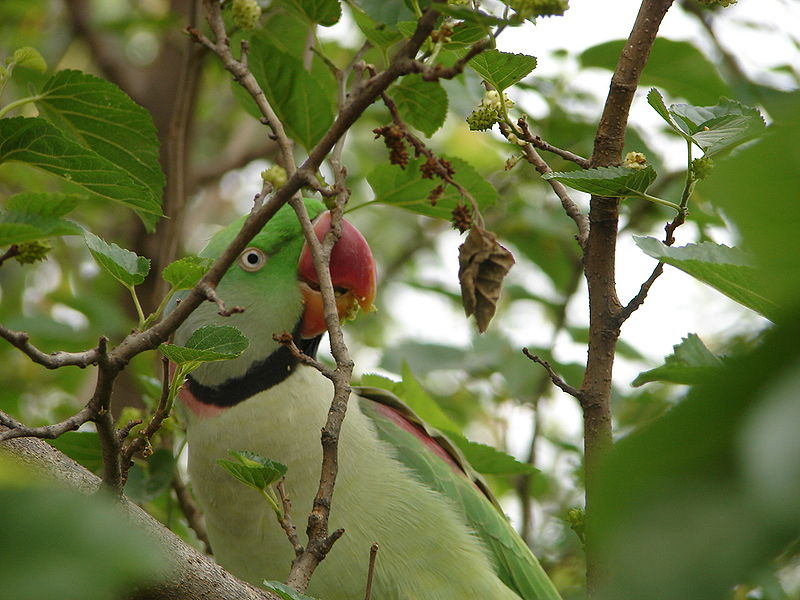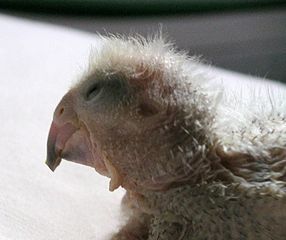 Parrot conservation news is usually dominated by stories covering large, popular species, such as African Greys, Black Palm Cockatoos and Amazons. While interest in these threatened birds is commendable, I also find it useful to focus my reading and writing on less well-known parrots and parrot habitats; for example, please see this article on Echo Parrot Conservation. Today I’d like to address parrot conservation concerns in India.
Parrot conservation news is usually dominated by stories covering large, popular species, such as African Greys, Black Palm Cockatoos and Amazons. While interest in these threatened birds is commendable, I also find it useful to focus my reading and writing on less well-known parrots and parrot habitats; for example, please see this article on Echo Parrot Conservation. Today I’d like to address parrot conservation concerns in India.
India’s Parrots and Parakeets
India is home to 12 parrot species, but, overshadowed by the needs of country’s tigers, rhinos and elephants, they have a hard time competing for public attention and funds. Adding to the problem, perhaps, is the popularity of the Indian Ring-Necked Parakeet, a hardy species that has established feral populations in such unlikely places as NYC. The fact that all of India’s wildlife is protected by law furthers the false sense of security.
Most Indian parrots belong to the genus Psittacula, and are collectively known as Ring-Necked Parakeets. Also native to this hub of bird biodiversity (over 1,300 avian species have been recorded) is the amazing Vernal Hanging Parakeet, Loriculus vernalis (please see this article). Most natives are poorly studied; one, the Intermediate Parakeet, has never been seen in the wild, and may be a captive-generated hybrid.
Extent of the Black Market Trade
It has been illegal to collect any native Indian bird since 1990. However, Indian poachers, more organized than those in most other countries, are proving especially difficult to stop. In fact, they seem a breed onto themselves – recently an individual was arrested while trying to kill a rhino…in a zoo!
Studies and confiscations reveal that 8 parrot species are regularly taken from the wild. Of these, the Nicobar, Long-tailed and Derbyan Parakeets are classified as Threatened or Near Threatened by the IUCN. The most widely-collected species is the Alexandrine Parakeet; please see the article below for updates on a recent seizure of Alexandrine Parakeet chicks.
As chicks aged 3-4 months dominate the trade, losses among captured birds are high. Although it is common knowledge that wild-caught adults make poor pets, they too are collected. Most of the contraband parrots are sold in Mumbai, Delhi and other large cities, while others are smuggled out of the country through Nepal, Pakistan and Bangladesh.
Identification Poster Distributed

Further Reading
Alexandrine Parakeet seizure; progress report, photos
Image of the TRAFFIC India poster
India’s parrots: species list and photos
Birds in Indian cities: surprising and familiar avian “urbanites”
Psittacula derbiana image referenced from wikipedia and originally posted by Doug Janson
Alexandrine Parakeet image referenced from wikipedia and originally posted by Amir85
 That Bird Blog – Bird Care and History for Pet Birds
That Bird Blog – Bird Care and History for Pet Birds




Is it legal to have a Alexandrine Parakeet in India?
I am eager to get one but there are lots of inputs from different people. I am just confused if I can really have one at my home.
Also I am aware about the consequences of petting an Alexandrine Parakeet.
Thanks,
Rashmi Jain
Hello Rashmi,
A contact who has worked on conservation projects informs me that the law is unclear. All native species of birds are protected and may not be kept as pets. However, in some places captive-produced color strains (i.e. not the natural color) have been “informally” allowed, while in other places within India they are considered illegal to possess. Sorry I could not be more specific. Perhaps someone in the Wildlife Division of the Ministry of Environment and Forests can provide a definite answer?
Best, Frank
I was surprised to see large parrot and not i know it’s Alexandrian in my balcony , this was not ready to leave and quite scared of crows and even hungry. I had no option to allow it in balcony otherwise this would have died of hunger or crows would have killed it.
When I showed it to other in building they told me that parrots are not allowed as pet and hence someone must of left it open. It is cruel, when i saw condition of parrot my wife fet so emotional she was all against keeping parrot in cage and she is even now.. but now we have problem .. we have kep this parrot open in in another balcony which is covered by pigeon net , we are scred to enter that balcony as this is huge parrot. We want to know what to do.. i called up BMC and they told me to contact fire brigade. I know i will be told to go from one door to another just to save this parrot.
I feel sad that government has ordered to release caged parrots in open when they cant feed on themself and cant take care..
Ajay Chavan, Mumbai
Sorry for your difficult situation. Many parrots do adjust remarkably well once they have been out for a few days…even here in NYC, semi-tropical species are established and breeding, despite control efforts, harsh winters and predators. Of course, many perish in their first few days of freedom, but those that get past this point often adjust . Best regards, Frank
Sir, is it legal to keep the mutated forms of Indian rose ringed parakeet as pets? i.e blue, white, yellow.. etc
Hello,
Unfortunately, I cannot provide a definite answer. A former co-worker and several readers from India have noted that the laws seem unclear or at least their application is unclear. I was told that in some places captive-produced color strains have been “informally” allowed, while in other places within India they are considered illegal to possess. Sorry I could not be more specific. Perhaps someone in the Wildlife Division of the Ministry of Environment and Forests can provide a definite answer? Best regards, Frank
pls give us the details about the indian parrot
Hello,
Please let me know what type of information you are seeking, and what birds interest you.
Best regards, Frank
can u guide me how to rehabilitate those poor caged bird … ?? is any procedure to release them in to the jungle ..?? i think you have idea that we cant release directly to their habitat … we need to keep dem in a big aviary n den need to keep observe on them n rehabilitate then i guess we can release them in to the wild …
may i have the enclosure design n measurement for parrots rehabilitation aviary from you brother .. ?
may i know how to rehabilitate them … can u mail me the whole procedure from start to end .. ??
Hello,
Thanks for your interest and concern. Details vary as to each species. However, in most places it is illegal to release captives into the wild, even if they are native. This is to prevent the spread of diseases which may not be apparent in pets w/o a medical exam, or to which they have developed an immunity. A situation such as this caused great losses among wild Desert Tortoises in the USA some years ago. It would be best to check with your local government wildlife agency before proceeding.
Best regards, frank
Hello.i got a baby rose ringneck parakeet as a gift. Is this legal to kept it as a pet. The history of that chick is that his his mother is of a green colour and his father is of a yellow colour. And now this chick is a green coloured . so it is indirectly came under the colour mutation
Hello,
I do not know where you are located – laws vary from state to state and country to country; your government’s local wildlife department would be your best source of information; please let me know if you need further info, best, frank
I have a Indian Ringneck, an alexandrine and two plum heads in different cages. I’m thinking of keeping them all together in my garage which is about 10x10x10. What all precautions are to be taken if I have to keep them all together without any cages?
There is no fan or any electrical item you can say mini aviery. Gate side iron net and wall from all side.
main quest is can they stay togather without fighting or bullying.
please help.
Hello,
Unfortunately it’s difficult to know if they will get along, as there are many variables, and individual birds differ greatly in this regard. And aggression could break out if nesting occurs, even if they were getting along prior. I wouldn’t do any major work in garage w/o perhaps trying birds together in a room…this is still not a guarantee, but may give you some idea of how they interact. best. Frank
Thanks for your quick reply.
one more thing i forgot to mention is they are in the same garage till now sinse last 3-4 months but in diffrent cage. Plum headed pair in one cage and female IRN is with male Alexandrine in other cage. Dont worry both are below age of one year amd plum headed is also one year of age now.
i want to give them little more freedom so i want to know that can i keep all togather as they all will get good exercise along with food and toys…good light.
My pleasure…would still be hard to predict, as all could change once they settle in, establish territories, etc., but worth testing, enjoy, frank
Hi, I am thinking of buying a blue alexandrine parrot because I love they way they are and they wonderful personalities. I live in Tamil Nadu and don’t know if it is legal. I am only interested in buying colours such as blue yellow and white. Would this be legal? Please give me some advice. I am stuck.
Thank you for writing. You would have to check with your local governing body, if this type of bird would be legal to own as a pet.
What governing body should I contact? Any specific wildlife communities or what?…..
You would have to check with your local government, and they can direct you to the proper dept.